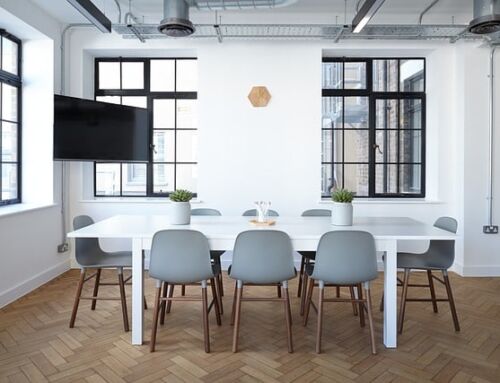In today’s fast-paced work environment, having effective meeting spaces is crucial for boosting collaboration and productivity. Modern meeting spaces are designed to go beyond traditional conference rooms, offering features that make it easier for teams to work together, brainstorm ideas, and make decisions quickly. This article explores the key features of modern meeting spaces and how they enhance collaboration and productivity.
Image by rawpixel.com on Freepik
Flexible Layouts
One of the most important aspects of modern meeting spaces is flexibility. Unlike traditional meeting rooms with fixed furniture arrangements, modern spaces often feature movable furniture and modular components. This flexibility allows teams to rearrange the room according to their needs. For example, you might need a large space for a brainstorming session or smaller areas for breakout discussions. Flexible layouts make it easy to adapt the room to different types of meetings and activities.
Advanced Technology Integration
Technology plays a crucial role in enhancing the effectiveness of modern meeting spaces. Here are some of the key technological features:
- High-Quality Video Conferencing: With remote work becoming more common, having a reliable video conferencing system is essential. Modern meeting spaces are equipped with high-definition cameras, microphones, and speakers that ensure clear communication between in-person and remote participants.
- Interactive Whiteboards: Traditional whiteboards are being replaced by interactive digital whiteboards. These smart boards allow users to write, draw, and share information in real-time. They also often integrate with other software, making it easy to save and distribute meeting notes.
- Wireless Presentation Systems: Modern meeting spaces typically feature wireless presentation systems that allow participants to share their screens without the need for cables. This ease of use helps streamline presentations and keeps the focus on the content rather than the technology.
- Integrated Sound Systems: Good acoustics are vital for effective communication. Modern meeting spaces often include integrated sound systems that ensure everyone can hear and be heard clearly, reducing misunderstandings and improving overall communication.
Comfortable and Ergonomic Furniture
Comfortable furniture is another key feature of modern meeting spaces. Ergonomic chairs and adjustable tables ensure that participants can focus on the meeting without discomfort. Comfortable seating also encourages longer and more productive meetings. Additionally, modern furniture often includes features such as built-in charging ports and adjustable lighting to further enhance the meeting experience.
Natural Lighting and Ventilation
The design of modern meeting spaces often includes elements that promote a healthy and productive environment. Natural lighting is one such feature. Studies have shown that natural light can boost mood and productivity. Modern meeting spaces often include large windows or skylights to bring in natural light and create a more inviting atmosphere.
Good ventilation is also important. Proper airflow can help keep participants alert and focused. Many modern meeting spaces are designed with advanced HVAC systems that ensure a comfortable temperature and air quality throughout the meeting.
Collaborative Tools and Resources
To facilitate effective collaboration, modern meeting spaces are equipped with various tools and resources:
- Digital Collaboration Platforms: Tools like shared digital whiteboards and project management software are often integrated into modern meeting spaces. These platforms allow team members to collaborate on documents, track progress, and manage tasks in real-time.
- Modular Furniture: Furniture that can be easily moved or reconfigured supports different types of meetings and collaborative activities. Modular furniture often includes options for creating smaller, more intimate areas within the larger meeting space.
- Interactive Displays: Large interactive displays or touchscreens are common in modern meeting spaces. These displays can be used for presentations, interactive discussions, and as a central hub for sharing information.
Acoustics and Privacy
Acoustic design is an important consideration in modern meeting spaces. Poor acoustics can lead to miscommunication and reduced productivity. Modern meeting spaces are often designed with sound-absorbing materials and strategic layouts to minimize noise distractions and enhance audio clarity.
Privacy is also a key factor. Many modern meeting spaces include features that allow teams to conduct confidential discussions without worry. This can include soundproofing, private rooms, and secure digital communication tools.
Creative and Inspiring Design
The design of modern meeting spaces often incorporates elements that inspire creativity and innovation. This can include:
- Art and Decor: Modern meeting spaces often feature artwork or design elements that create a stimulating environment. This can include murals, sculptures, or themed decor that reflects the company’s culture or mission.
- Flexible and Dynamic Spaces: Instead of static, uniform designs, modern meeting spaces might include areas that can be easily adapted for different uses. This can include movable partitions, flexible seating arrangements, and areas for informal discussions.
- Comfort and Aesthetics: The overall look and feel of the meeting space are important for creating a welcoming and comfortable environment. Modern meeting spaces often feature contemporary design elements, high-quality materials, and attention to detail.
Sustainability and Eco-Friendliness
Sustainability is becoming an increasingly important consideration in the design of modern meeting spaces. Many spaces are now incorporating eco-friendly practices and materials:
- Energy-Efficient Lighting: LED lighting and other energy-efficient options reduce electricity consumption and lower operating costs.
- Sustainable Materials: Furniture and materials made from recycled or sustainable sources help reduce the environmental impact of the meeting space.
- Green Certifications: Some modern meeting spaces are designed to meet green building standards, such as LEED certification, which ensures that they meet high environmental performance criteria.
The Role of Meeting Spaces in Organizational Culture
Modern meeting spaces also play a role in shaping organizational culture. A well-designed meeting space can reinforce a company’s values and mission. For example, a space designed to encourage collaboration and open communication reflects a company culture that values teamwork and transparency.
Moreover, modern meeting spaces can help attract and retain talent. A well-designed, comfortable, and technologically advanced meeting space can make a positive impression on employees and potential hires, contributing to a more attractive and competitive workplace.
Conclusion
Modern meeting spaces are more than just rooms where meetings happen. They are carefully designed environments that enhance collaboration and productivity through flexible layouts, advanced technology, comfortable furniture, and creative design. By incorporating these features, organizations can create spaces that not only support effective meetings but also contribute to a positive and productive work environment.
As we move forward, the evolution of meeting spaces will continue to focus on integrating new technologies, promoting sustainability, and fostering a culture of collaboration. By staying ahead of these trends, companies can ensure that their meeting spaces remain effective tools for achieving their business goals.







Leave A Comment